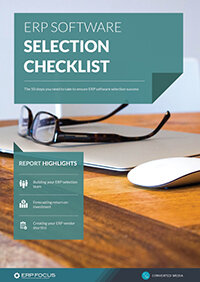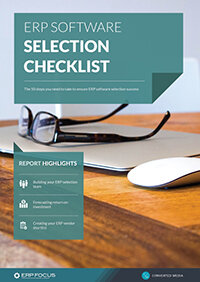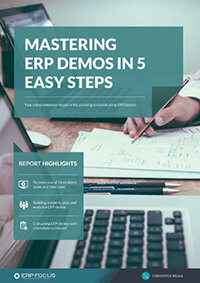Understanding the importance of a sound ERP selection process
With the future of managing your company’s growth at stake, it’s never been more important to follow a well-defined, thorough vetting process when selecting an ERP software vendor. By doing so, you’ll be able to deliver against the timeframe, confidently defend the validity of your selection based on the information at hand, and ultimately, bring the experience to a positive and successful conclusion.
Before following these steps, we recommend your company organize an ERP project team (or selection committee) to develop a Request for Proposal (RFP), if deemed necessary, organize and supervise the ERP selection process, and oversee the entire installation and implementation of the software solution. It is often advantageous to make appropriate department managers part of the team, along with executive management and your company’s IT representatives.
If you haven’t yet established a selection process, here are recommendations for an effective procedure.
1. Review the project budget
Determine what your organization is prepared to invest for an ERP solution. It is very beneficial for you and the ERP vendor to articulate a preliminary price range and projected timeframe for this project in the initial phase of the vetting process. Granted, you may need more information, gathered during the discovery phase of your process, to narrow the price range, scope, and timeframe, however this initial step will help you better qualify your list of potential ERP vendors.
2. Conduct meaningful, qualifying conversations
Most of these conversations will occur via email and telephone as you trim your list of ERP vendor candidates. You’ll want to determine if the ERP vendor knows, understands, and has experience serving your industry. Quiz the ERP vendor about its knowledge of industry best practices, compliance, and regulatory challenges. Discuss deployment options. Ask yourself, “Does this vendor meet our criteria and fit with our corporate culture?”
Recommended reading: ERP software selection checklist - a 50-step plan for your project
If you’ve prepared an RFP, here’s the time to refer to it. That invaluable document, if constructed carefully and completely, should detail the specifics of your needs as well as details pertinent to the selection process itself. In this step, it is important to clarify with your list of vendors: (1) your critical functional requirements and exactly what functionalities your selection committee must see demonstrated, (2) your regulatory requirements, number of users, and the current software landscape being used, (3) the timeframe for your selection process and product demo. Once you’ve narrowed the list of viable candidates, you’re ready for the discovery stage.
3. Collect valuable information during discovery
A discovery is an instrumental step in the process. Discoveries may be performed remotely, though many participants prefer to conduct discovery activities onsite––face-to-face conversations, information gathering meetings, targeted Q & A with all stakeholders and key users of the ERP software, and a tour of your facility. Be prepared for plenty of discussion. It is of importance at this time to share key information, such as critical needs, nice to haves, and future needs with each ERP vendor, especially specifics having a major impact on your candidate selection. Don’t assume anything. Be clear about your needs and expectations of the ERP vendor.
4. Schedule an ERP software demonstration
It is essential during your ERP selection process that you observe the ERP vendor’s software in action during an interactive demonstration. With the data you’ve previously provided, each vendor candidate should demonstrate key functions such as recipe formulating, quality testing, or BOM preparation. It is critical to have the vendor demonstrate your must-have features. This demonstration may be conducted onsite or via the web, depending upon the ERP vendor’s preference.
It is essential during your ERP selection process that you observe the ERP vendor’s software in action during an interactive demonstration.
The goal of the product demonstration is for the ERP vendor to show how its software delivers to the critical needs of your company. To get the most value from this demonstration, make sure that you: (1) include the proper stakeholders and decision makers in the process, (2) allow enough time for the ERP vendor to adequately spotlight the software, (3) ask pertinent, key questions, and finally, (4) share with the ERP vendor the criteria you will use to select the ERP vendor of choice.
5. Reduce “vendor blur” post demonstration
Post demonstration is the time to conduct follow-up activities, get clarification, review touch points, and identify those characteristics among ERP vendors that differentiate one from the other. Also use this time to clarify and/or reconfirm with each short-listed vendor what should be included in the proposal, number of users, and features.
This review is especially important if your ERP selection committee has many candidates from which to choose and the differences between them have begun to blur over the course of the demonstration process. Revisit product functionality that is especially critical for your company. Finally, make certain that you compare ERP vendors point-by-point equally, apples-to-apples. Again, this activity will narrow the field of contenders/vendors.
6. Enter the proposal/final negotiation phase
Your selection committee should discuss the merits of each ERP vendor finalist, comparing pros and cons, and charting characteristics for easier comparison. Drill down to finer points of differentiation: ease-of-use, feature set, or the combination of strong features, industry knowledge, and support. Implementation and support methodology might be more comprehensive with one vendor than the others. One ERP vendor might have more expertise in your industry. Or it all might boil down to which candidate provided a better experience during the selection process.
Drill down to finer points of differentiation: ease-of-use, feature set, or the combination of strong features, industry knowledge, and support.
Evaluate each ERP vendor’s proposal. Understand all costs and benefits as well as price differentiators between vendors – for example, named versus concurrent users. Ensure there are no budget surprises. Finally, ask about financing, lease options, and the benefits of paying cash.
Never underestimate the importance of a clearly defined ERP selection process. By executing all steps of the process, you’ll better understand your needs and feel confident that your choice of ERP vendor offers the most benefits to your organization. Your process will help you ascertain the best ERP software vendor for your company; one that meets your critical requirements, aligns well with your corporate culture, and provides the most comprehensive solution, resulting in a high level of return on your ERP investment.
Free white paper

60-Step ERP Selection Checklist
Get the comprehensive checklist for your ERP selection project

Featured white papers
-

ERP Software Pricing Guide
Get the latest pricing information on over 80 popular ERP systems, and learn how to budget for your ERP project in our free guide
Download -

60-Step ERP Selection Checklist
Get the comprehensive checklist for your ERP selection project
Download -

ERP Demo Guide & Scorecard
Master your ERP demo with 5 easy steps using our free guide (includes demo scorecard)
Download
Related articles
-

The best ERP systems for process manufacturing
Consider these ERP systems when selecting your next process manufacturing ERP
-

Secret KPI: Why Your ERP Implementation Team Matters More Than Software
Learn how Godlan ensures successful ERP implementation for manufacturers with proven strategies &...
-

5 ERP pricing definitions you need to understand
Have you mastered the ERP pricing lexicon yet? Getting to grips with these five definitions is a ...

